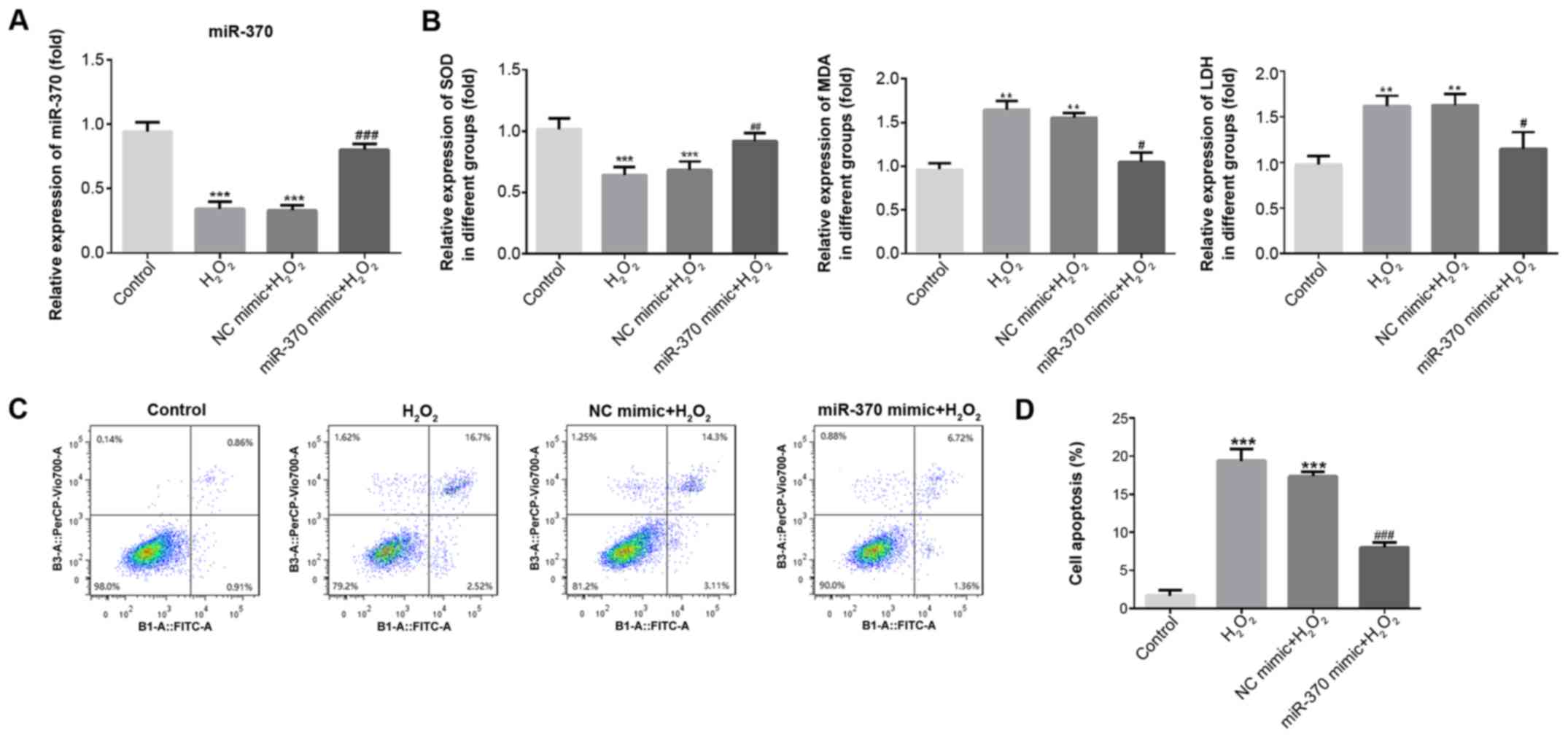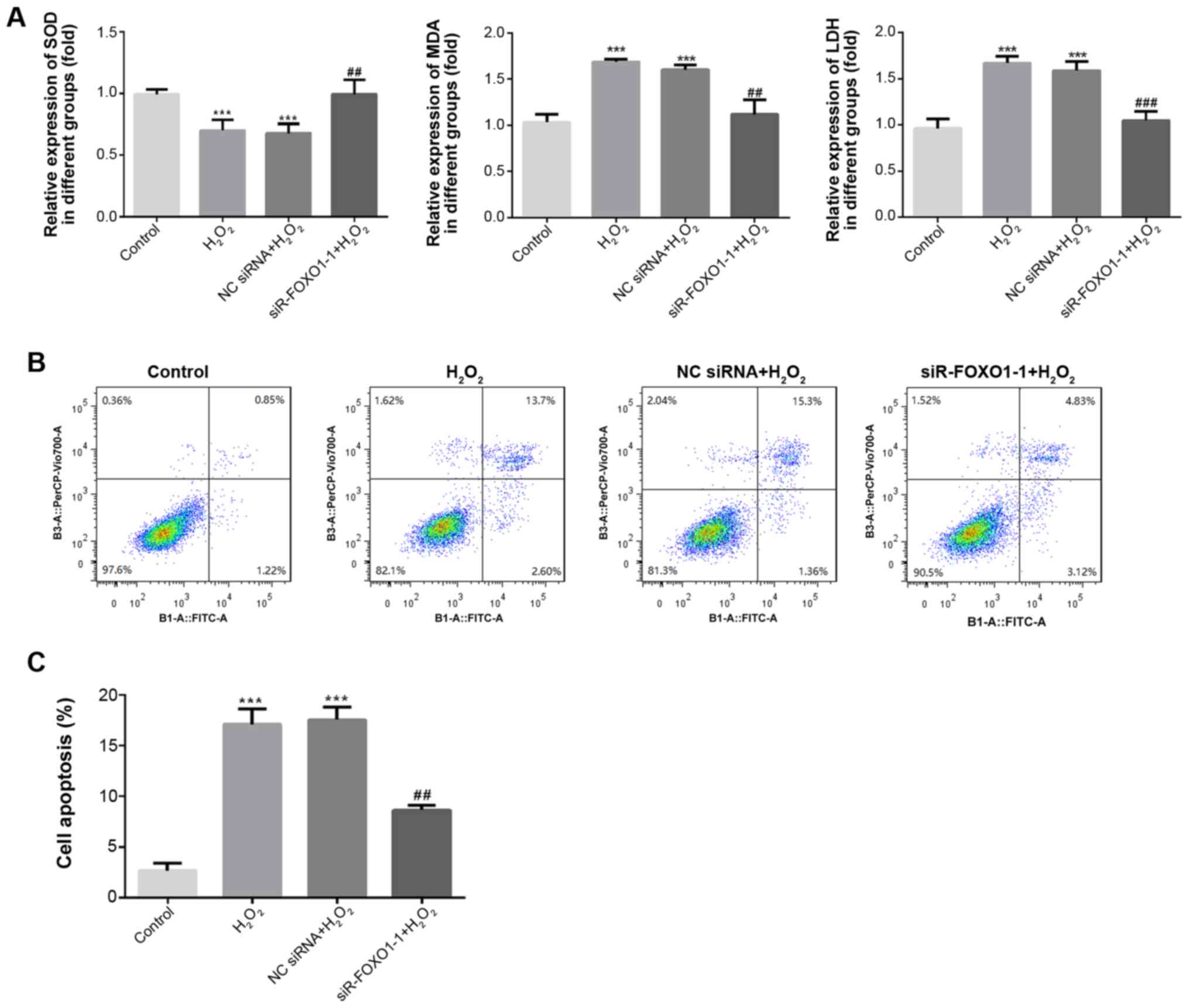|
1
|
Poole-Wilson P: The prevention of
cardiovascular disease worldwide: Whose task and WHO's task? Clini
Med (Lond). 5:379–384. 2005. View Article : Google Scholar
|
|
2
|
Porter KE and Turner NA: Cardiac
fibroblasts: At the heart of myocardial remodeling. Pharmacol Ther.
123:255–278. 2009. View Article : Google Scholar : PubMed/NCBI
|
|
3
|
Qiu H, Liu JY, Wei D, Li N, Yamoah EN,
Hammock BD and Chiamvimonvat N: Cardiac-generated prostanoids
mediate cardiac myocyte apoptosis after myocardial ischaemia.
Cardiovasc Res. 95:336–345. 2012. View Article : Google Scholar : PubMed/NCBI
|
|
4
|
Katz AM and Messineo FC: Lipid-membrane
interactions and the pathogenesis of ischemic damage in the
myocardium. Circ Res. 48:1–16. 1981. View Article : Google Scholar : PubMed/NCBI
|
|
5
|
Abbate A and Narula J: Role of apoptosis
in adverse ventricular remodeling. Heart Fail Clin. 8:79–86. 2012.
View Article : Google Scholar : PubMed/NCBI
|
|
6
|
Navarro-Yepes J, Burns M, Anandhan A,
Khalimonchuk O, del Razo LM, Quintanilla-Vega B, Pappa A,
Panayiotidis MI and Franco R: Oxidative stress, redox signaling,
and autophagy: Cell death versus survival. Antioxid Redox Signal.
21:66–85. 2014. View Article : Google Scholar : PubMed/NCBI
|
|
7
|
Morales CR, Pedrozo Z, Lavandero S and
Hill JA: Oxidative stress and autophagy in cardiovascular
homeostasis. Antioxid Redox Signal. 20:507–518. 2014. View Article : Google Scholar : PubMed/NCBI
|
|
8
|
Ogura S and Shimosawa T: Oxidative stress
and organ damages. Curr Hypertens Rep. 16:4522014. View Article : Google Scholar : PubMed/NCBI
|
|
9
|
Farias JG, Molina VM, Carrasco RA, Zepeda
AB, Figueroa E, Letelier P and Castillo RL: Antioxidant therapeutic
strategies for cardiovascular conditions associated with oxidative
stress. Nutrients. 9(pii): E9662017. View Article : Google Scholar : PubMed/NCBI
|
|
10
|
Brown DI and Griendling KK: Regulation of
signal transduction by reactive oxygen species in the
cardiovascular system. Circ Res. 116:531–549. 2015. View Article : Google Scholar : PubMed/NCBI
|
|
11
|
Krol J, Loedige I and Filipowicz W: The
widespread regulation of microRNA biogenesis, function and decay.
Nat Rev Genet. 11:597–610. 2010. View Article : Google Scholar : PubMed/NCBI
|
|
12
|
Guo H, Ingolia NT, Weissman JS and Bartel
DP: Mammalian microRNAs predominantly act to decrease target mRNA
levels. Nature. 466:835–840. 2010. View Article : Google Scholar : PubMed/NCBI
|
|
13
|
Baek D, Villen J, Shin C, Camargo FD, Gygi
SP and Bartel DP: The impact of microRNAs on protein output.
Nature. 455:64–71. 2008. View Article : Google Scholar : PubMed/NCBI
|
|
14
|
Orenes-Pinero E, Montoro-Garcia S, Patel
JV, Valdes M, Marin F and Lip GY: Role of microRNAs in cardiac
remodelling: New insights and future perspectives. Int J Cardiol.
167:1651–1659. 2013. View Article : Google Scholar : PubMed/NCBI
|
|
15
|
Joladarashi D, Thandavarayan RA, Babu SS
and Krishnamurthy P: Small engine, big power: microRNAs as
regulators of cardiac diseases and regeneration. Int J Mol Sci.
15:15891–8911. 2014. View Article : Google Scholar : PubMed/NCBI
|
|
16
|
Chen C, Ponnusamy M, Liu C, Gao J, Wang K
and Li P: MicroRNA as a therapeutic target in cardiac remodeling.
Biomed Res Int. 2017:12784362017. View Article : Google Scholar : PubMed/NCBI
|
|
17
|
Chen XP, Chen YG, Lan JY and Shen ZJ:
MicroRNA-370 suppresses proliferation and promotes endometrioid
ovarian cancer chemosensitivity to cDDP by negatively regulating
ENG. Cancer Lett. 353:201–210. 2014. View Article : Google Scholar : PubMed/NCBI
|
|
18
|
Feng Y, Sun T, Yu Y, Gao Y, Wang X and
Chen Z: MicroRNA-370 inhibits the proliferation, invasion and EMT
of gastric cancer cells by directly targeting PAQR4. J Pharmacol
Sci. 138:96–106. 2018. View Article : Google Scholar : PubMed/NCBI
|
|
19
|
Tian D, Sha Y, Lu JM and Du XJ: MiR-370
inhibits vascular inflammation and oxidative stress triggered by
oxidized low-density lipoprotein through targeting TLR4. J Cell
Biochem. 119:6231–6237. 2018. View Article : Google Scholar : PubMed/NCBI
|
|
20
|
Yuan H and Gao J: The role of miR370 in
fibrosis after myocardial infarction. Mol Med Rep. 15:3041–3027.
2017. View Article : Google Scholar : PubMed/NCBI
|
|
21
|
Wu H, Gao H, Gao S, Lei Z, Dai L, Wang X,
Han Y, Wang Z and Han L: A Chinese 4-herb formula, Yiqi-Huoxue
granule, alleviates H2O2-induced apoptosis by
upregulating uncoupling protein 2 in H9c2 cells. Phytomedicine.
53:171–181. 2019. View Article : Google Scholar : PubMed/NCBI
|
|
22
|
Livak KJ and Schmittgen TD: Analysis of
relative gene expression data using real-time quantitative PCR and
the 2(-Delta Delta C(T)) method. Methods. 25:402–408. 2001.
View Article : Google Scholar : PubMed/NCBI
|
|
23
|
Xu G, Zhu H, Zhang M and Xu J: Histone
deacetylase 3 is associated with gastric cancer cell growth via the
miR-454-mediated targeting of CHD5. Int J Mol Med. 41:155–163.
2018.PubMed/NCBI
|
|
24
|
Qi R, Huang J, Wang Q, Liu H, Wang R, Wang
J and Yang F: MicroRNA-224-5p regulates adipocyte apoptosis induced
by TNFα via controlling NF-κB activation. J Cell Physiol.
233:1236–1246. 2018. View Article : Google Scholar : PubMed/NCBI
|
|
25
|
Wu J, He D, Yue B, Zhang C, Fang X and
Chen H: miR-101-1 expression pattern in Qinchuan cattle and its
role in the regulation of cell differentiation. Gene. 636:64–69.
2017. View Article : Google Scholar : PubMed/NCBI
|
|
26
|
Zhang K and Guo L: MiR-767 promoted cell
proliferation in human melanoma by suppressing CYLD expression.
Gene. 641:272–278. 2018. View Article : Google Scholar : PubMed/NCBI
|
|
27
|
Tian D, Sha Y, Lu JM and Du XJ: MiR-370
inhibits vascular inflammation and oxidative stress triggered by
oxidized low-density lipoprotein through targeting TLR4. J Cell
Biochem. 119:6231–6237. 2018. View Article : Google Scholar : PubMed/NCBI
|
|
28
|
Yuan H and Gao J: The role of miR-370 in
fibrosis after myocardial infarction. Mol Med Rep. 15:3041–3047.
2017. View Article : Google Scholar : PubMed/NCBI
|
|
29
|
Liu H, Yang N, Fei Z, Qiu J, Ma D, Liu X,
Cai G and Li S: Analysis of plasma miR-208a and miR-370 expression
levels for early diagnosis of coronary artery disease. Biomed Rep.
5:332–336. 2016. View Article : Google Scholar : PubMed/NCBI
|
|
30
|
Hoekstra M, van der Lans CA, Halvorsen B,
Gullestad L, Kuiper J, Aukrust P, van Berkel TJ and Biessen EA: The
peripheral blood mononuclear cell microRNA signature of coronary
artery disease. Biochem Biophys Res Commun. 394:792–797. 2010.
View Article : Google Scholar : PubMed/NCBI
|
|
31
|
Hu J, Chu Z, Han J, Zhang Q, Zhang D, Dang
Y, Ren J, Chan HC, Zhang J and Huang Y: Phosphorylation-dependent
mitochondrial translocation of MAP4 is an early step in
hypoxia-induced apoptosis in cardiomyocytes. Cell Death Dis.
5:e14242014. View Article : Google Scholar : PubMed/NCBI
|
|
32
|
Chang H, Li C, Huo K, Wang Q, Lu L, Zhang
Q, Wang Y and Wang W: Luteolin prevents H2O2-induced apoptosis in
H9C2 cells through modulating Akt-P53/Mdm2 signaling pathway.
Biomed Res Int. 2016:51258362016. View Article : Google Scholar : PubMed/NCBI
|
|
33
|
Liu X, Tong Z, Chen K, Hu X, Jin H and Hou
M: The role of miRNA-132 against apoptosis and oxidative stress in
heart failure. Biomed Res Int. 2018:34527482018.PubMed/NCBI
|
|
34
|
Wilhelm K, Happel K, Eelen G, Schoors S,
Oellerich MF, Lim R, Zimmermann B, Aspalter IM, Franco CA, Boettger
T, et al: FOXO1 couples metabolic activity and growth state in the
vascular endothelium. Nature. 529:216–220. 2016. View Article : Google Scholar : PubMed/NCBI
|
|
35
|
Wang Z, Ji G, Wu Q, Feng S, Zhao Y, Cao Z
and Tao C: Integrated microarray meta-analysis identifies miRNA-27a
as an oncogene in ovarian cancer by inhibiting FOXO1. Life Sci.
210:263–270. 2018. View Article : Google Scholar : PubMed/NCBI
|














